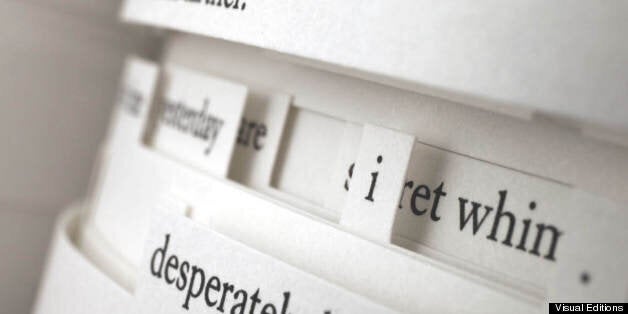
The future of print is a bright one, as my new book, Fully Booked - Ink on Paper: Design and Concepts for New Publications (Gestalten, $60), attempts to prove.
It's a showcase of innovative physical book designs from around the world co-edited by Robert Klanten, Matthias Hübner and myself. Below is an edited version of my introduction, a message from a parallel universe similar yet a little different to our own. -- Andrew Losowsky, Senior Books Editor, The Huffington Post
Let me state this for the record: The internet is not dead. Digital will not disappear. Print will not kill the web.
It's easy to forget that, when physical books were invented, professional websites first ignored them, and then laughed at them as a niche pursuit for geeks. Now here we are, and the same writers are declaring the Death of the Internet, as the hype and excitement surrounding print and paper travels inexorably around the world. News companies have even themselves rushed into creating 'news-papers', long before any clear business model has emerged to pay for them. We are in a print world now.
It has changed so many things in our lives that it can be hard to remember a time before print, when everything was digital. Yet doing so is the only way to understand exactly why and how print became so important, so quickly.
Of course, when the first companies started to print books, they were pale imitations of the on-screen experience, near-perfect reproductions of the visual language of digital without any of its functions or its essence. People who grew up with digital laughed at these early iterations, dismissing the idea that print could ever have a value beyond being a pale echo of the digital reading experience. They would never, they swore, read a book printed on paper. It simply wasn't the same experience as that with which they'd grown up.
However, print began to take off among the elderly and the young, the former embracing the simplicity and highly limited demands of interactivity offered by print, while the latter came quickly to understand the near-limitless freedoms granted by physical ownership.
The phenomenon of handmade scrapbooks grew, as teenagers realized that with print, images could be cut out, remixed, stuck with glue into collages without having to break the rights management on a digital device, while others soon learned they could write whatever they wanted alongside the text in the privacy of their homes, without a publisher or platform limiting, monitoring and perhaps sharing their words.
People have now come to understand that once a print book is purchased, they truly own their personal edition of that story. There are no limitations to what they can do with it or to it. There are no licenses (though early print publishers tried, absurdly, to insist on including some with their titles), no terms and conditions that must be applied to how we will use a book. Keeping a book requires no legal contract whatsoever.
At last, with print books, we have come to understand what it is like not to be forever leasing information. We can destroy, lend, scribble, mail our books from one country to another in ways that digital platforms stubbornly refuse to permit. If we decide to change the make of our digital device, we need to re-purchase or re-license "our" ebooks, movies, music all over again; but print books remain accessible no matter how or where we choose to read them. It is truly an "open" platform.
No wonder most publishers and technology companies initially fought in the courts against the inevitable rise of print - they feared how it might rewrite the contract between creator and consumer. They were right to be afraid.
There remain a few people who say that they wish print could be uninvented. It could certainly be argued that our lives in those exclusively digital days were simpler and less cluttered. Information only existed in its digital form, connected to everything else in a single click, filled with links to a thousand other sources that then led you to other sources, distractions piled upon distractions. The rabbit hole never ended, and we never wanted it to end.
Everything that we read back then was shareable instantly and globally, but, though we never realized it at the time, all of that information had little or no actual presence. A single link on, say, Facebook was hard to pick out from a constantly updated stream of hundreds of other links, photographs and ideas. We lived in the river, a few of the drops making contact with our skin while the rest flowed by, unseen and uninterrupted.
Even if someone personally sent you a particular URL via email or Twitter, the nature of the exchange was swift and more than a little soulless. There was no sacrifice and little effort implicit in the exchange. Its association with the formless nature of the medium cheapened the information itself, no matter how important or meaningful its intent.
Today, we can give someone a real book as a gift, we can lend them our personal copy of the text, we can physically place the stories into their hands and their homes in a far more personal and memorable way. By occupying space, by having weight and heft, by utilizing smells and tactility as part of their own stories, books have impact.
There is much we can learn from information that isn’t always changing and striving to "improve" itself. Through static text, we can witness the changing nature of human thought in action, and follow cultural and ideological shifts. Without the permanence of print, we can only do this through digital scraps gathered by university libraries and the Internet Archive. Data without true fixity is as reliable as a hard disk – which means it can be instantly accessed, easily wiped, often replaced, and occasionally corrupted, deliberately or no.
Thanks to print, reading itself has become a more solitary pursuit, with a renewed focus. Unlike an ever-reproducible digital file or webpage, a physical book is a solitary experience that can only be enjoyed by one person at a time. When we finish a book, we close the cover and are left in peace; there is no online store pushing us instantly to buy and read more. There are no in-book purchases to be made as we read. No advertisements will ever pop up related to our reading experience. No videos or chat windows or alerts attempt to distract us from our internal thinking processes. Numerous studies have shown that since the arrival of print, people’s ability and duration of maintaining attention on a single idea has increased. Print is literally changing how we think, and how we look at the worlds around us.
Today, we are surrounded by an entire print-based landscape, with books being published in all subjects you can imagine, in virtually every language. No longer the preserve of craft nerds and design fetishists, now books can be found in virtually every home in the western world, sold and read on what seems like every street corner. There are pocket books and coffee-table books, paperbacks and hardbacks. There is no turning back.
Little if any of this was in the minds of the early print pioneers. Now, however, no company working in the digital space can ignore what print has brought to our lives, and print has reacted accordingly. The two are engaged not in a fight, but a dance. Print or digital? That question is as redundant as asking which is better, red or green? We are in a print AND digital world, and they are better for each other's existence. By watching and learning how and why people love each medium, the strengths of one is learning how to overcome the weaknesses of the other.
In the case of digital, those strengths include connectedness, ubiquity, unlimited and near-instant supply, multimedia capabilities, multiple input possibilities via digital devices, shareability and the option to include near-constant updating of information, thereby emphasizing the fragility of "the fact." As for print, its strengths include presence, physicality, lack of compatibility issues, complete ownership of the object, the unchanging and private act of reading, personalization and the inclusion of smell and touch as part of the experience. These are complementary functions of existence.
Thanks to the new energy and ideas provided by print, we now see that far from being at its zenith, the digital age is just getting started.
We are entering a new golden age of reading, in all of its forms. Long live print.
See images from Fully Booked: Ink on Paper:

